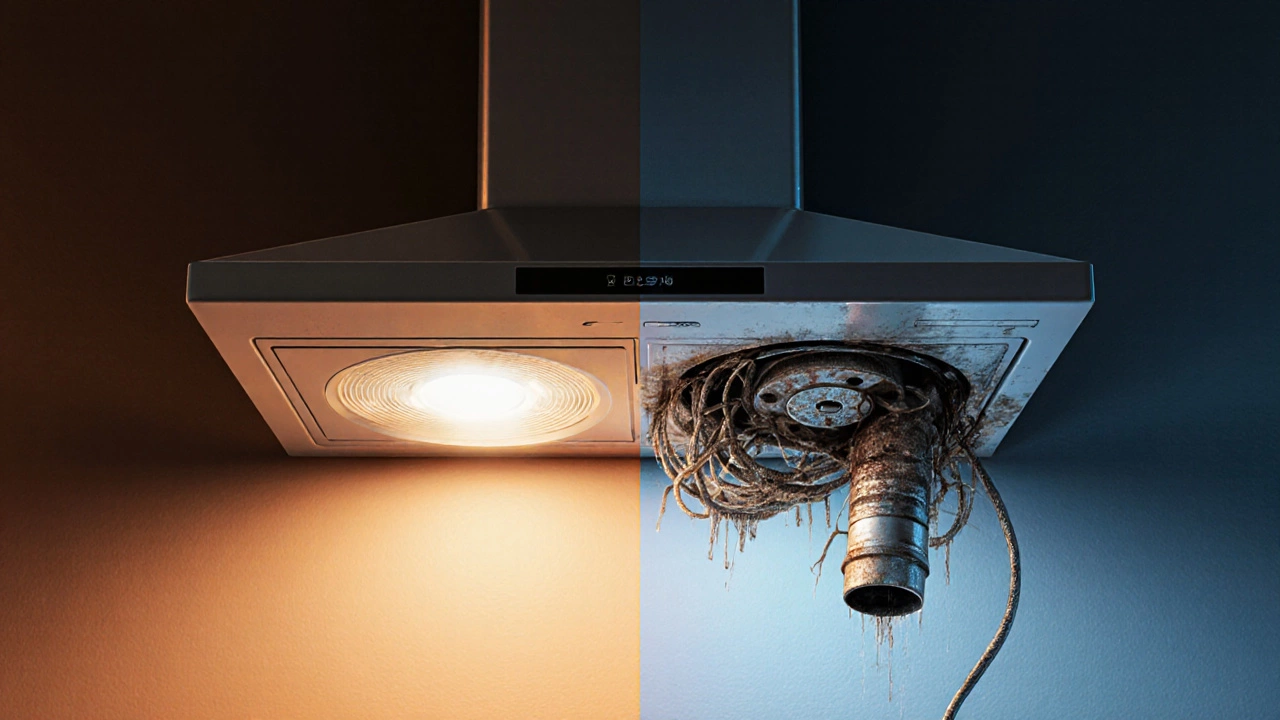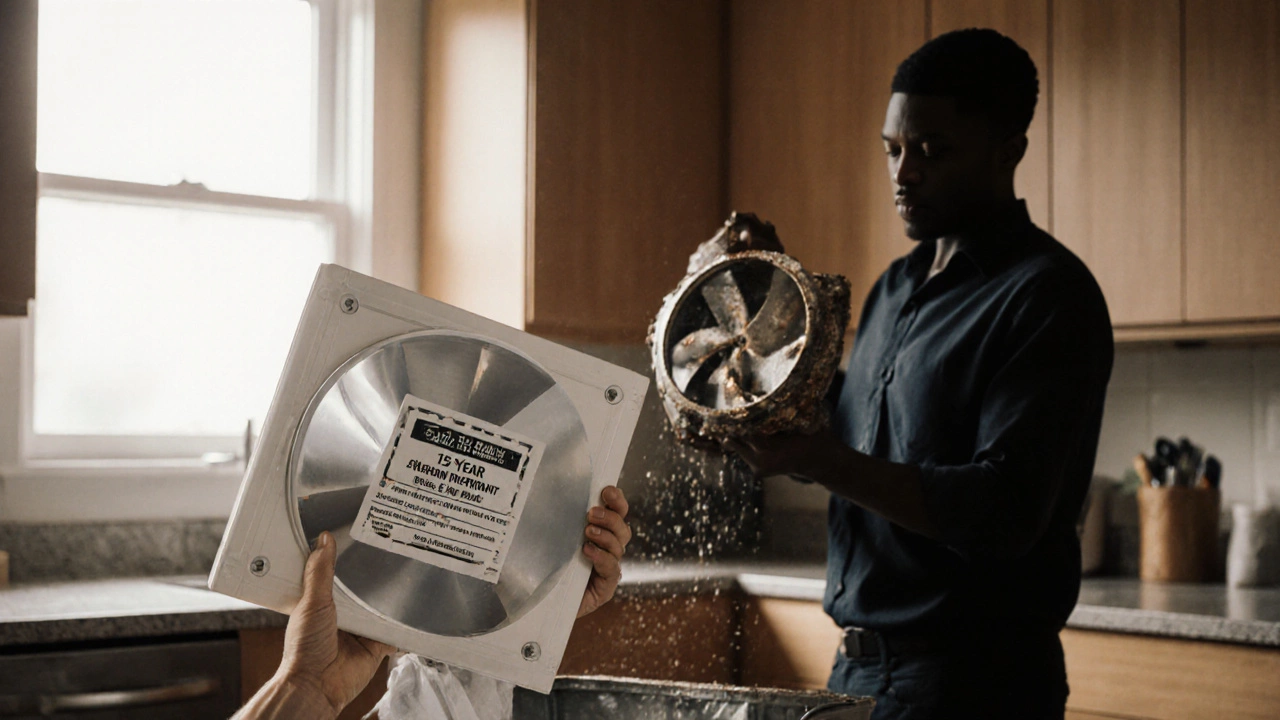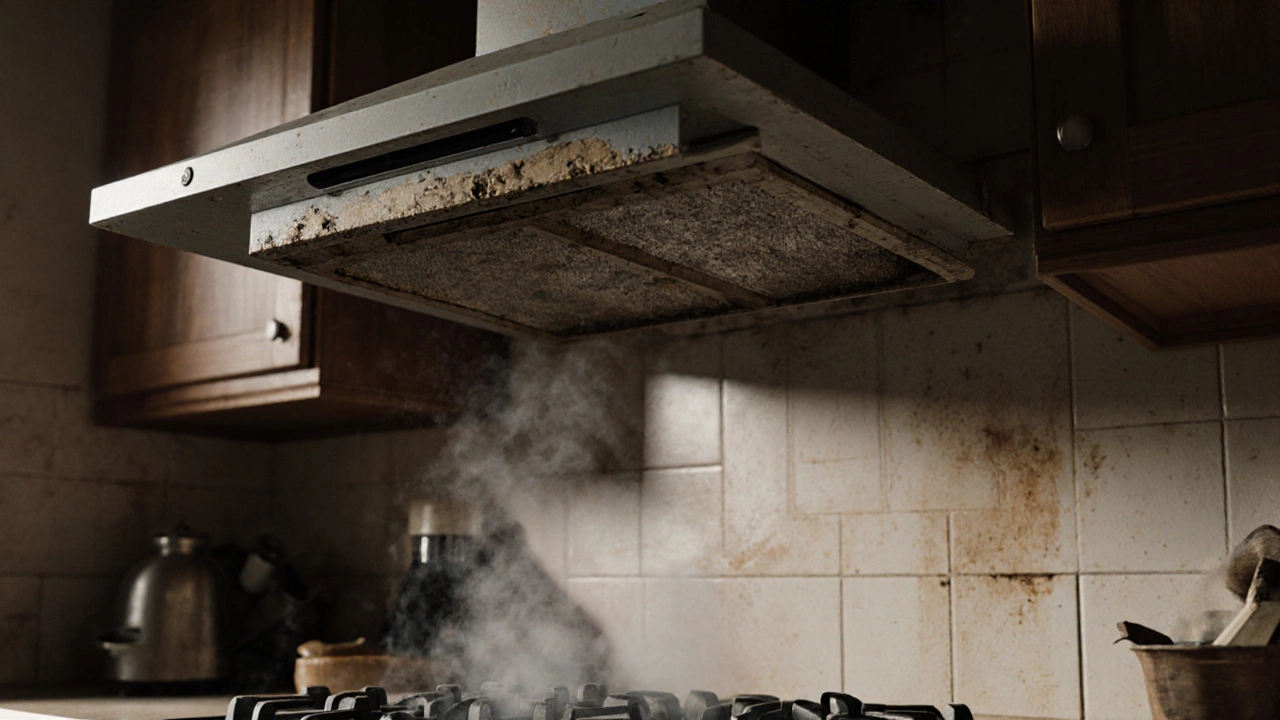Most people don’t think about their kitchen extractor fan until it stops working. Then suddenly, smoke lingers, grease builds up on the walls, and the smell of last night’s stir-fry hangs around for days. You wonder: how long do kitchen extractor fans last? The answer isn’t simple. Some last 10 years. Others die in 3. It depends on how you use it, what kind it is, and whether you clean it at all.
Typical Lifespan: 5 to 15 Years
On average, a kitchen extractor fan lasts between 5 and 15 years. That’s a wide range because not all fans are made the same. A basic, low-cost model bought from a hardware store might only last 5 to 7 years, especially if it’s running every day. Higher-end models from brands like Extracto, Zephyr, or Bosch, with better motors and sealed bearings, often last 10 to 15 years - if maintained.
Here’s what actually kills them: dust, grease, and heat. The motor doesn’t fail from age. It fails because grease clogs the bearings. Dust builds up on the blades, making the motor work harder. Over time, that extra strain burns out the windings. In a busy home, where someone fries eggs or stir-fries veggies daily, the fan’s lifespan shrinks fast.
Signs Your Extractor Fan Is Done
You don’t need a technician to tell you when it’s time. These signs are clear:
- The fan is louder than ever - rattling, buzzing, or screeching instead of humming.
- It doesn’t pull air anymore. Hold a piece of tissue near the grille. If it doesn’t stick, the motor’s weak or the impeller’s clogged.
- Grease drips from the filter or housing. That’s not normal. It means the grease trap is full, and oil’s getting into places it shouldn’t.
- The light flickers or dies. Many fans have built-in lighting. If that goes out along with the fan, the control board is likely fried.
- You smell burning plastic or overheating. This isn’t a minor issue. Turn it off immediately. It’s a fire risk.
One common mistake: people think cleaning the filter is enough. It’s not. The motor, the ductwork, and the impeller need attention too. In coastal areas like Dunedin, salt air speeds up corrosion. Metal parts rust faster. Plastic housings become brittle in the heat.
What Shortens Extractor Fan Life?
Three things cut a fan’s life in half:
- No cleaning - Grease builds up inside the motor housing and on the blades. In 2 years, a dirty fan can lose 40% of its airflow.
- Running non-stop - Leaving it on for hours after cooking, especially on high speed, overheats the motor. It’s not designed for continuous use.
- Blocked ducts - If the vent pipe is crushed, kinked, or stuffed with bird nests, the fan has to work harder. That’s like running a car with a clogged air filter.
One homeowner in Dunedin replaced their fan every 4 years because they never cleaned the duct. After a professional cleaned the 8-meter vent pipe - packed with grease and fluff - their new fan ran quietly for 9 years. Cleaning the duct matters as much as cleaning the filter.

How to Make It Last Longer
You can double or even triple your fan’s life with simple habits:
- Wash the metal grease filter every 2 weeks. Soak it in hot water and dish soap. Rinse well. Dry completely before putting it back.
- Vacuum the grille and housing every 3 months. Use a brush attachment to get grease out of crevices.
- Check the duct every year. Pull the fan out slightly (if possible) and look inside. If you see thick grease or debris, call a pro.
- Don’t run it on high unless you’re searing steak. Low or medium speed works fine for most cooking.
- Replace charcoal filters in recirculating models every 6 months. They stop working when saturated.
These steps take less than 20 minutes a month. But they’re the difference between replacing a fan every 5 years and having it last 12.
Repair vs Replace: When to Do Which
Is it worth repairing? Sometimes. But not always.
Repair makes sense if:
- The fan is less than 7 years old.
- Only the motor or capacitor is dead - both are replaceable parts.
- The housing and duct are in good shape.
Replace it if:
- The fan is over 10 years old - parts are hard to find, and new models are 30% more efficient.
- The casing is cracked or rusted - you can’t fix structural damage.
- The duct is damaged or poorly installed - no new fan will work well if air can’t escape.
- It’s a recirculating model without a duct - they’re less effective and harder to maintain.
One repair technician in Dunedin says he sees 30 extractor fan repairs a month. Half of them are for fans older than 12 years. He tells people: “If you’re spending $150 to fix a 15-year-old fan, you’re just paying to delay the inevitable.”

What to Look for in a New Fan
If you’re replacing it, here’s what matters:
- CFM rating - For a standard kitchen, aim for 100-150 CFM (cubic feet per minute). Bigger kitchens or those with gas stoves need 200+ CFM.
- Noise level - Look for 4 sones or less. Anything above 6 is annoying.
- Motor type - Brushless DC motors last longer and use less power than old AC motors.
- Easy-to-clean filters - Dishwasher-safe metal filters are a plus.
- Ducted vs recirculating - Always choose ducted if you can. Recirculating fans don’t remove moisture or odors well.
Brands like Elica, Falmec, and Broan have models with 15-year motor warranties. That’s a good sign they expect them to last.
What Happens If You Don’t Replace a Dead Fan?
Ignoring a broken extractor fan isn’t just annoying - it’s risky.
- Moisture builds up - That leads to mold on walls, ceilings, and cabinets. In damp climates like Dunedin, mold grows fast.
- Grease coats surfaces - It’s hard to clean, attracts pests, and can ignite if it gets hot enough.
- Indoor air quality drops - Cooking fumes contain carcinogens. Without extraction, you’re breathing them in.
- Home value drops - Buyers notice smelly, stained kitchens. A broken fan is a red flag.
One real case: a couple in Dunedin sold their home. The inspector flagged the extractor fan as non-functional. The buyers demanded a $2,000 credit for repairs. The sellers ended up spending $2,400 to replace the fan and repaint the ceiling.
How often should I clean my kitchen extractor fan?
Clean the grease filter every 2 weeks if you cook often. Vacuum the housing and grille every 3 months. Check the duct for blockages once a year. If you use your stove heavily - frying, grilling, or wok cooking - clean more often. Grease builds up faster than you think.
Can I repair my extractor fan myself?
You can replace the filter, clean the housing, and check the duct without tools. But if the motor’s dead, the capacitor is blown, or the wiring is faulty, leave it to a professional. Kitchen fans involve electricity and sometimes gas vents. DIY repairs can be dangerous if you’re not trained. Plus, a bad repair can void any warranty.
Do extractor fans with lights last longer?
The light doesn’t affect the fan’s lifespan. But if the light and fan stop working together, it’s usually a sign the control board is failing. That’s a common failure point in cheaper models. High-end fans use separate circuits, so the light and fan can fail independently.
Are ductless (recirculating) extractor fans worth it?
Only if you can’t install a duct. Recirculating fans use charcoal filters to trap grease and odors, but they don’t remove moisture or heat. That means your kitchen stays humid, and smells linger. They’re less effective than ducted fans and need filter replacements every 6 months. If you have a choice, always go ducted.
How much does it cost to replace a kitchen extractor fan?
A basic replacement fan costs $150-$300. Installation by a professional runs another $100-$250, depending on duct work. High-end models with smart features or silent motors can cost $500-$1,000. If your duct needs cleaning or rerouting, add $200-$400. But a $300 fan that lasts 12 years is cheaper than a $100 fan you replace every 4 years.
Final Thought: Think Long-Term
Extractor fans aren’t glamorous. But they’re essential. A good one quietly protects your kitchen, your health, and your home’s value. Don’t wait for it to fail completely. Clean it regularly. Listen to the sounds it makes. If it’s struggling, act early. Replacing a fan before it dies saves you money, stress, and a greasy ceiling.
